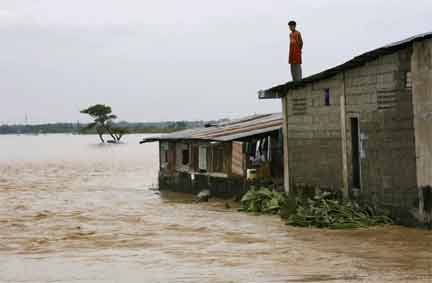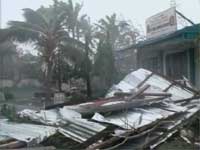Philippines - storms
Death toll rises after storm wreaks havoc on Philippines
Article published on the 2009-10-09 Latest update 2009-10-09 14:10 TU
"The rains in this area are unprecedented," Glen Rabonza of the National Disaster Coordinating Council told the AFP news agency. "We are stretched, no doubt, but we are responding in the best way we can."
At least 120 people died in landslides in five towns in Benguet province overnight, according to provincial governor Nestor Fongwan. Officials confirmed another 38 dead in the mountain resort town of Baguio.
Days of rain have forced authorities to open five dams, flooding about 60 per cent of Pangasinan province, according to Rabonza, and dozens of towns.
"The [San Roque] dam is supposed to be for flood control, but now it is so filled it is like it is not there,” said Pangasinan governor Amado Espino. “The water just rushes right through from the mountains to Pangasinan."
Thousands of people are stranded on rooftops, being rescued with makeshift bamboo rafts, as the overwhelmed government does not have enough rubber boats to go around.
Further south in the capital, Manila, about 300,000 homeless are still in makeshift evacuation camps after tropical storm Ketsana dropped record rains there on 26 September, killing at least 337 people.
Reaction: Satur Ocampo, congressman, Manila
Congressman Satur Ocampo says that Manila was overwhelmed by the water because structures had been built in areas designed for water runoff.
“There was no where that the water could flow out in the ocean,” he told RFI, blaming the government for not regulating construction.
“There was practically unregulated construction of business and residential houses,” he said. “It will require a huge reengineering of the metropolitan area.”
The leftwing politician from the Bayan Muna party also criticised official relief efforts.
“The disaster and relief and rescue operations were proven totally inadequate,” he said. “That’s why we had to call for international support… The private sector had to contribute because government doesn’t have the facilities.”
Philippines/South-east Asia - typhoons
Arroyo puts Philippines under state of calamity
2009-10-03 12:49 TU
South-east Asia - Ketsana aftermath
Rescue efforts continue as storm toll hits 312
2009-09-30 13:29 TU









